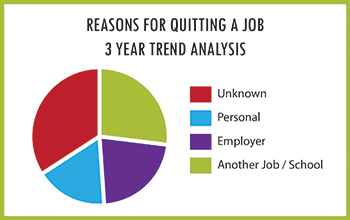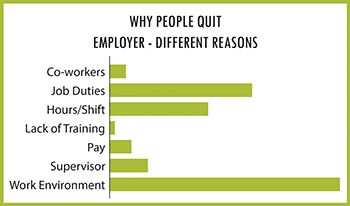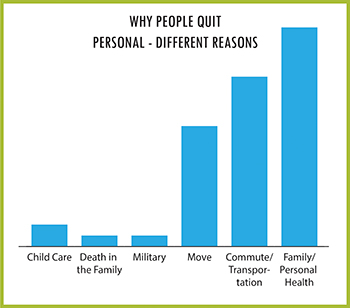
Why Your Employees are Quitting
A look at the trends
Employees are quitting jobs at a record pace. The fact is that this is an employees’ market and, in most cases, there are more jobs than there are qualified people to fill them. Entry level positions in Service (e.g. restaurant, hospitality, retail) and Production (e.g. general laborer, line worker, assembly) as well as Skilled Jobs (e.g. engineering, accounting) are in high demand. This shortage of workers has existed for five years now and the longer this ‘labor market’ subsists, the more employees will understand their worth and quickly jump ship for the next shiny opportunity. Take the labor market and then add the millennials, who are expected to job hop every couple of years, and today’s employers are faced with a crisis. One way to combat this is to understand the current trends and why employees are leaving.
 I conducted my own analysis and looked at almost five thousand quits over the past 3 years. The biggest reason for quitting fell under the category ‘Unknown’, which includes employees who refused to identify why they quit, just left without telling anyone or never showed up to work. The No Call/No Show trend is sometimes referred to as “ghosting” and makes up over 95% of this category. No Call/No Show (NCNS) is defined on Wikipedia as ‘an absence from the workforce without notifying the employer, this form of absence is generally deemed inconsiderate and unprofessional’. Ghosting is a new term and according to Wikipedia it refers to the ending of a relationship by cutting off all contact and ignoring attempts to be contacted. Originally the term referred to only romantic relationships but has recently been adapted to the No Show/No Call job phenomenon. If you have been ghosted by an employee, know you are not alone. NCNS has seen an upward trend in the past 3 years.
I conducted my own analysis and looked at almost five thousand quits over the past 3 years. The biggest reason for quitting fell under the category ‘Unknown’, which includes employees who refused to identify why they quit, just left without telling anyone or never showed up to work. The No Call/No Show trend is sometimes referred to as “ghosting” and makes up over 95% of this category. No Call/No Show (NCNS) is defined on Wikipedia as ‘an absence from the workforce without notifying the employer, this form of absence is generally deemed inconsiderate and unprofessional’. Ghosting is a new term and according to Wikipedia it refers to the ending of a relationship by cutting off all contact and ignoring attempts to be contacted. Originally the term referred to only romantic relationships but has recently been adapted to the No Show/No Call job phenomenon. If you have been ghosted by an employee, know you are not alone. NCNS has seen an upward trend in the past 3 years.
It is not surprising that employees are quitting jobs for another opportunity or to go back to school. This category continues to grow. The millennial generation thrives on collecting experiences and job change allows them to achieve this.
 Employees also quit because they don’t like something about their current employer or the company culture. Employers often feel this isn’t something that is easily changed, such as the duties of the assignment and work environment (too hot, too cold, dusty, too fast, too slow, odor, too heavy or too physical and too much standing to name a few). It’s just part of the job.
Employees also quit because they don’t like something about their current employer or the company culture. Employers often feel this isn’t something that is easily changed, such as the duties of the assignment and work environment (too hot, too cold, dusty, too fast, too slow, odor, too heavy or too physical and too much standing to name a few). It’s just part of the job.
Top Reasons Why People Quit an Employer
- Work environment / culture 40%
- Duties assigned 25%
- Hours or Shifts 17%
The hours and shifts are another big reason for employees to quit because of an employer. Despite knowing shift expectations when offered the position, frequently employees decide they don’t like shifts or can’t do them and leave. Employees also cite supervisor, co-workers, pay and lack of training as reasons they quit an employer.
 Lastly, employees quit jobs because of many personal reasons that may have nothing to do with the employer directly. A high percentage of people that quit jobs for personal reasons are due to health reasons directly affecting them or a close family member. This is alarming and something Canadian employers should be mindful of.
Lastly, employees quit jobs because of many personal reasons that may have nothing to do with the employer directly. A high percentage of people that quit jobs for personal reasons are due to health reasons directly affecting them or a close family member. This is alarming and something Canadian employers should be mindful of.
As well, many employees quit because they change their mind about the commute or they lose their method of transportation, child care arrangements fall through or they simply move away.
As an employer you will need to take a close look at your organization and find enhancement opportunities to ensure your jobs are appealing to the workforce available, in most cases the millennials. Ask yourself – what would make us more attractive to job seekers? Is there something that can be changed in the work environment or the culture to persuade employees to stay? Nothing in my statistics indicates that pay is a huge factor, as long as your wages are competitive. Employees are looking for a good environment where they feel healthy with a good work/life balance. The labor market doesn’t appear to be changing, so it is up to employers to find a way to attract and maintain the workforce needed to be successful. Once you identified the areas in your organization that make it appealing, promote them! After all, we are competing for employees in this labor market and employees have proven that they will quit jobs to better their work/life balance or collect their next experience.
 About the Author
About the Author
Jackie Beynen
Jackie Beynen is the Operations Manager at SRG, overseeing all of our offices in Southern Ontario. She spends much time analyzing our workforce trends and working closely with our Workforce Development Managers to best service our valued clients. She is actively involved in her community and enjoys traveling which she does several times a year.
Please share our posts…

